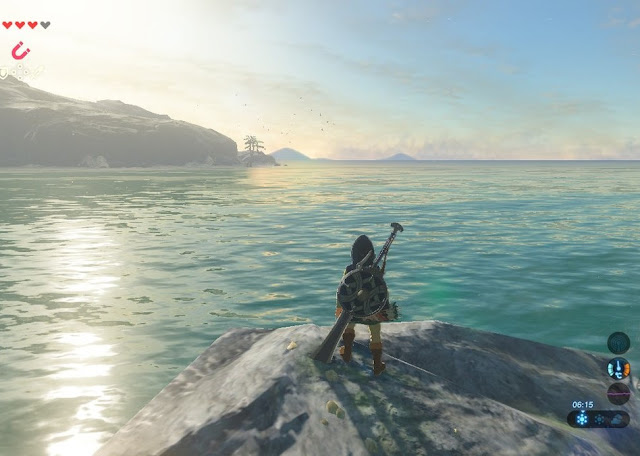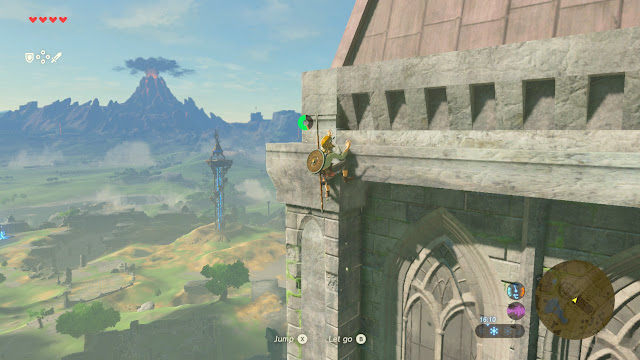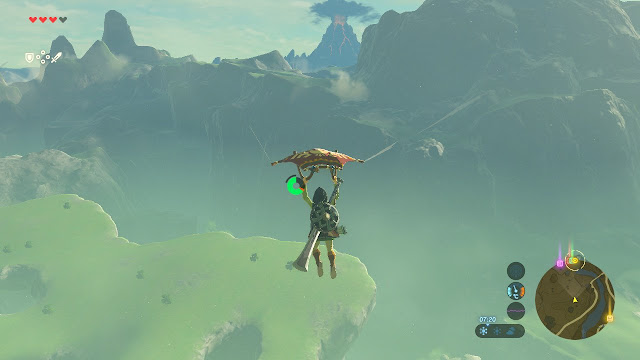Review by Brad L.
It’s no secret that the Legend of Zelda is my favourite game series of all time. The Legend of Zelda: A Link to the Past is my personal favourite Zelda game and the game I consider to be the best of all time. Despite this love that I have for the series, I have been burned before by The Legend of Zelda games, most particularly the Zelda games that have been released over the past eight years. For me, Spirit Tracks was the ultimate low of the series, with Triforce Heroes and Skyward Sword not being that far above that particular title. In fact, the only reasonably good title, A Link Between Worlds, suffered from being far too simplistic for my lofty expectations. I feel that I need to mention this at the outset to me review of The Legend of Zelda: Breath of the Wild, because it’s important to note that this series is not infalable, and indeed, has hit the point where it needs to start proving itself again.
It is also important to say that I had lofty expectations for Breath of the Wild, from the initial teaser video to the extended trailer released in January. I avoided most of the hype as I wanted to experience the world of Hyrule for myself, and I can say that Breath of the Wild has exceeded my expectations in almost every way.
Breath of the Wild, for all the steps it takes forwards in offering players an open world, is also a brilliant return to its roots, with enough elements from other Zelda titles meshed together to form one of the most breathtaking games I have ever played. Many people forget that the original Legend of Zelda was created as an open-world game of sorts. There was no real set path that dragged players down a linear path, as has happened in recent years. Breath of the Wild takes the concept presented through that very first game to a whole new level. Link is just about able to travel wherever he pleases once he progresses through the prologue. It’s true adventuring.
In fact, the only real inhibitor to your ability to go anywhere with Link is his stamina gauge, which he uses to swim, run, climb and glide through the landscape. Link needs this stamina gauge upgraded over time in order to reach higher cliffs, cross wider rivers and so on. This does leave some areas locked off until later on in the game, but boy does it feel like a light touch restriction at times.
The narrative of the game is its weakest point, but that’s not to say it is a directionless game. Plot points feel like they are being drip fed to Link, but only with the sheer amount of activity I took part in between the main quests. Without spoiling too much, Link has awoken from a slumber of 100 years, resurrected for the purposes of banishing Calamity Ganon. Ganon has taken over Hyrule Castle after using Sheikah technology against the denizens of Hyrule, and it is up to Link to recover his lost memories, and strengthen himself in order to overcome Calamity Ganon and the possessed Sheikah technology. Of course, this is an over simplified version of the narrative, it does go into much more detail, but giving out that detail will clearly spoil elements of the narrative. It does come across as a commentary that uninhibited technological advancements can do more harm than good, though again it’s quite the light touch.
The Sheikah are represented in the game by creating this very advanced technology for the goodness of mankind from their genius, without regard of the idea that the technology could be used by evil. Even though Ganon is a looming threat, just like he is in other Zelda games, this is the first time that it hasn’t seemed like a silly notion that Link preoccupies himself with side quests and nonsense tasks instead of saving the world. The developers have finally created what I consider to be the first Zelda game where the narrative actually encourages Link to explore the world at his own pace and make his own discoveries, separate from the main plot, in order to find a solution to Ganon himself. Majora’s Mask came close due to its ability to allow the player to reset the time limit whenever they felt like it (represented by that now-infamous moon descending on the world), but there was still a huge sense of urgency to get things done in that game. Breath of the Wild definitely tells you to take the game at the player’s pace, something that hasn’t been done this well before.
At the start of the game, Link awakens from his aforementioned slumber. The voice of Zelda summons link from the shrine in which he slept and he emerges to see the expansive world of Hyrule. After some searching he stumbles upon the Old Man, reminiscent of the Old Man in the original Legend of Zelda game. With some basic instruction, Link sets out to retrieve some treasure for the Old Man in exchange for his glider. When Link discovers the treasure within the shrine, he finds that it is from a deceased Sheikah monk in the form of a Spirit Orb. These Spirit Orbs are given to Link once he has proven his courage to the monk by traversing the shrine. Once Link has achieved four Spirit Orbs, he is instructed to go to a certain building within the game and use the Spirit Orbs to pray to Hylia, the Goddess of Hyrule. This is significant, as the monks are seemingly passing on their soul to Link so that he can release those souls into the afterlife through Hylia. It is as though the monks have tethered themselves to the land, awaiting the day that The Hero arrives as a vessel of sorts to lead them to peace. It is a beautiful sentiment that carries its own independent narrative away from the focus of the game, even after you’ve repeated this process for some 20 monks.
The enemies in Breath of the Wild are the standard enemies from Zelda games. There are Bokoblins, Moblins, Lizalfos and the like. Their presence in Breath of the Wild humanises them somewhat. Link will find them dancing around campfires, chilling out in caves, and defending outposts. I was at first unsure if these typical Zelda enemies were there to fight me or not, they were clearly there enjoying their lives. It wasn’t until I disrupted their peace before it became clear it was their intention to kill Link. Other enemies are a group of Hylians that call themselves the Yiga Clan. Link will come across travellers, and soon discovers that this clan are a group of Ganon sympathisers, with the sole belief that Ganon will bring prosperity to Hyrule. The equivalent of Trump supporters, their sole mission is to solely serve who they believe to be the strongest in the land, despite what his plans for Hyrule are and stop the Hero from saving the general populace at all costs. Fighting other Hylians is a first in the series, and it was an interesting direction that the game took. With the overall scale of the game, I was impressed that they thought to include the idea that there probably are some Hylians who would choose a new ruler over the Royal Family of Hyrule.
In addition to the enemies of the game and the plot of the game, there are several side quests. Though not new to The Legend of Zelda, the side quests often show off a mini story of sorts. A particular side quest that was a favourite of mine was The Priceless Maracas. I discovered a large Korok by the name of Hestu. Hestu had been lonely as no one has been able to see him for 100 years aside from monsters and other Koroks. Hestu tells Link the tale that monsters have taken his beloved Maracas, so Link retrieved them for him. Upon witnessing the sheer joy of Hestu receiving his most prized possession, he realises the other Koroks have pulled a prank on him and have taken his seeds, so he cannot even enjoy his Maracas anymore. The side quest continues as Link searches Hyrule for the seeds. It’s an ongoing side quest, and sure it’s a glorified fetch quest, but it’s a testament to character design when it feels like each and every character has his or her own unique personality.
Each of these missions require some careful planning. A single side quest can potentially take upwards to an hour to do (treasure hunting quests aside). Link needs to plan an appropriate route that will allow his current level of health and stamina to make it through. Ensuring he has the right tools for the job is also beneficial, as some missions require Link to chop down trees and form a bridge to cross gaps, Link can use an axe, but in showing the versatility and freedom that the game offers, I also discovered that a large claymore will suffice as well.
Some of the most advanced technology is available to Link in the form of the Sheikah Tablet. This basically functions as a small smartphone-like device that Link can use to record maps, utilise runes (such as bombs), and record data in a kind of Hyrulian Wikipedia. This data can then be used by Link to track down shrines, as well as specific materials and weapons. Often this is useful to scan the topography and see exactly how steep cliff faces are and to see which route would be the best to take to reach a certain point. This was especially useful for me when I was finding a way to reach a shrine high up on the side of a mountain.
An unexpected element that came across that prevented me from reaching certain areas was the weather in the game. Early on, Link reaches a snowy mountaintop, and suddenly he was losing health. A quick check in the HUD revealed that I had a temperature gauge the whole time without realising it. Any time it reaches a low enough point, Link will start to freeze to death. Similarly, Link will burn to death whenever he comes across a hot area such as being near the edge of a volcano. Thankfully, Link can combine several ingredients and cook them to stay warm or cool in these areas. Link can also bring along warmer clothes for the colder climates too which is appreciated. There are also lightning storms to watch out for, and often these can get quite vicious, with a lightning bolt striking nearby dry grass or trees and setting them alight. I once used Link’s magnetic rune to hold his claymore near some enemies, the lightning was attracted to the metal and it fried my foes in an instant. There is ample opportunity to use your own creativity in solving problems, as you can see.
That creativity will need to come into play to be able to combat the many shrines in the game. Most of these only represent the size of one or two rooms in most other Zelda games, but the sheer number of shrines dotted around the map means that there are plenty of opportunities for puzzling in the game. There are large, full-sized dungeons too. There are a return to classic Zelda dungeon design, though there are far fewer of them. Talking about it in any kind of depth will likely spoil elements of the game, and may serve better for a future write up article.
The amiibo functionality is somewhat amusing. Every amiibo so far can be used, with every non-Zelda amiibo showering Link with materials from the sky, as if the Goddess Hylia approves of your expensive habit. I scanned all 118 of my amiibo and I’m looted up to the gills now. This can be seen as a form of cheating, and I get it. It does feel like the equivalent of giving developers money in order to do something arbitrary like “one-button fatalities” in Mortal Kombat. I believe this is why the default setting for amiibo functionality is set to “off”. The Zelda themed amiibo will drop chests with rare items. There are some unique items you can only get this way as well, so for some it will be worth it owning the Zelda themed amiibo at the very least. The amiibo can only be scanned once a day, so at least this feature can’t be spammed too much. Possibly the most unique amiibo function is being able to summon Wolf Link straight from Twilight Princess. Wolf Link proves to be a useful companion, as he will attack enemies and hunt down animals for you on your travels. Even riding horses, Wolf Link is generally able to keep up with you. His health is based on how much health Link has in Twilight Princess after defeating a certain section. The more health he has, the more useful Wolf Link becomes. It might be worth it to play through Twilight Princess on the Wii U again purely to “level up” your amiibo if you haven’t already.
It’s clear that the Switch has nowhere near power of the PlayStation 4 or Xbox One, but it’s amazing what Nintendo has achieved on a technical level with Breath of the Wild. The few screenshots I’ve taken just for this review are just a taste of the land of Hyrule. Seeing it all in motion is another thing altogether. While it will not look as technically impressive as a game like Horizon: Zero Dawn, the art direction driving the game makes it one of the most beautiful games I’ve ever played. There are some minor jitters in frame rates, but not enough that it will take anyone but the most anal of players out of the experience. I’ve lost myself in 5-hour play sessions without even realising it. Playing the game in handheld mode is just as gorgeous as playing it on a large television. The Switch’s screen really pulls out the vibrant colours of Breath of the Wild and allows the player to lose themselves just as easily.
The music has always been a staple of The Legend of Zelda games, and in Breath of the Wild, it has actually taken a little bit of a back step. Not in terms of quality, the music itself pleases the senses. Like with many open world games, music isn’t playing constantly. Instead, when Link approaches something important, the slow, familiar sound of a piano will play, and become more and more dramatic as Link gets closer and closer. It’s a good indicator that something significant is about to enter Link’s adventure, and doesn’t interfere too much with the game with a constant barrage of music like previous games in the series did.
The Legend of Zelda: Breath of the Wild has taken over A Link to the Past as my favourite game in the entire Zelda series. Therefore, Breath of the Wild has become what I consider to be the greatest game I have ever played. It does not have the narrative depth of other games reviewed on this site, but it is the first open-world game since the original Legend of Zelda that successfully tells the player to take it at their own pace (without feeling like you should be doing something else). Despite being developed initially for the Wii U, the Switch version is perfect for short handheld bursts or for longer play sessions in the living room. It is truly one of those rare games that’s simply worth buying a new device just to play.
– Brad L.
Contributor













